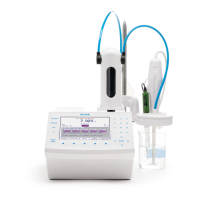1. GENERAL REVIEW OF TITRATION THEORY
1.1. INTRODUCTION TO TITRATIONS
A titration is a quantitative, volumetric procedure used in analytical chemistry to determine the concentration of an analyte (the
species being measured) in solution. The concentration of the analyte is determined by slowly adding a titrant (reagent) to the
solution. As the titrant is added, a chemical reaction occurs between the titrant and the analyte.
Titration reactions are relatively fast, simple reactions that can be expressed using a chemical equation. The titration reaction
continues as the titrant is added until all of the analyte is consumed and the analyte reacts completely and quantitatively with the
titrant.
The point at which all of the analyte has been reacted is called the equivalence point, also known as the theoretical or stoichiometric
endpoint. This point is accompanied by an abrupt physical change in the solution, which sharply defines the endpoint of the reaction.
The physical change associated with the titration endpoint can be produced by the titrant or an indicator and can be detected either
visually or by some other physical measurement.
Titrations cannot be used to determine the quantity of all analytes. The chemical reaction between the titrant and analyte must fulfill
four requirements:
• The reaction must be fast and occur within approximately one second after the titrant is added
• The reaction must go to completion
• The reaction must have well-known stoichiometry (reaction ratios)
• A convenient endpoint or inflection point
Titrations are highly precise and can provide many advantages over alternative methods. Titrations are quickly performed and
require relatively simple apparatus and instrumentation.
1.2. USES OF TITRATIONS
Titrations can be used in many applications, including:
• Acid content of plant effluents, food (e.g.: cheese and wine), plating and etching baths, petroleum products, drugs
• Base content of fertilizer (containing ammonia), bleach, minerals
• Hardness in water
• Metal content of alloys, minerals, ores, clays, waters, plating baths, paints, paper, plant materials, biological fluids, petroleum
products
• Moisture content in foodstuffs, petrochemicals, pharmaceutical products, and plastics
• Redox reagent concentrations such as available chlorine in potable water, peroxide, traces of oxidants and reductants in food,
reductants in high temperature or high pressure boiler water, vitamin analysis
1.3. ADVANTAGES AND DISADVANTAGES OF TITRATIONS
Some advantages of titrations as an analytical technique are:
• More precise results than many instrumental methods, such as measurement by electrode, the accuracy of the measurement is
up to 0.1%
• Simple methods, reasonable capital costs, and easy training
• Suitability to measure major components of a mixture or product
• Automation can reduce time and labor spent on each analysis
Some disadvantages of titrations are:
• Time it takes to prepare standards and titrants
• Good technique is required to achieve precise results (training and practice required)
• Not suitable for determining trace or minor components of a mixture or product
• Limited dynamic range, it may require additional sample preparations (dilution) and repeat analyses

